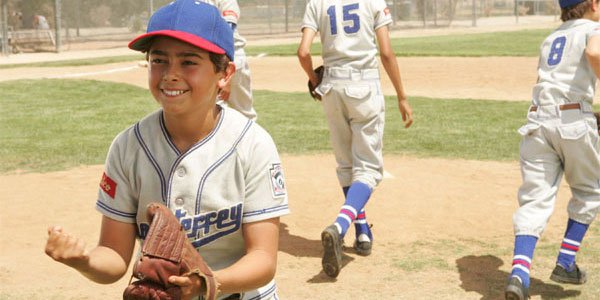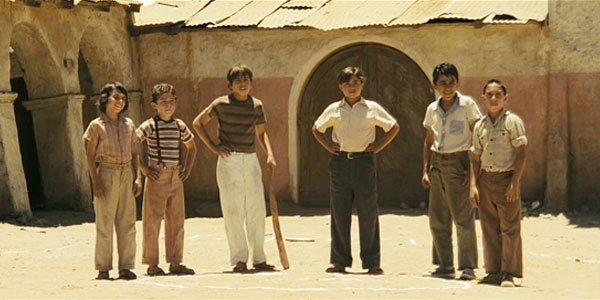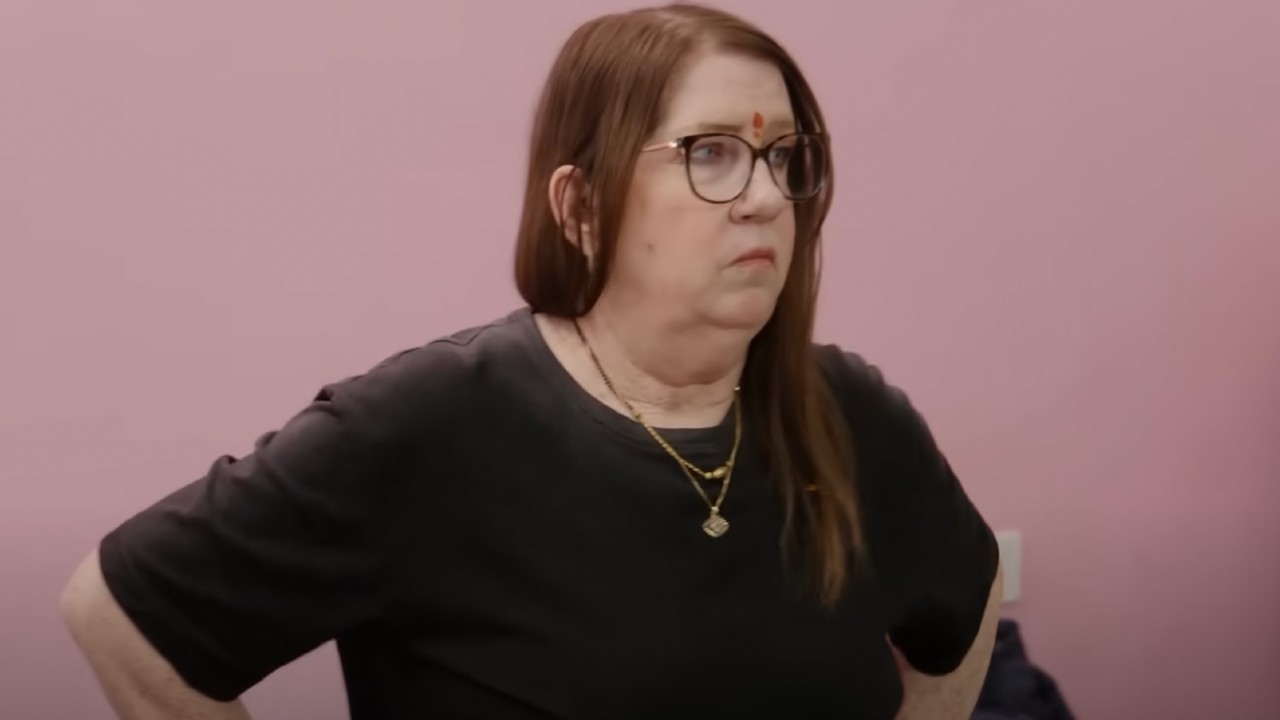Interview: The Perfect Game's William Dear And Jansen Panetierre

I’ve said it before, but I’ve got to say it again, there’s an unbelievable parallel between The Perfect Game and the true story on which it’s based. Back in 1957, the Monterrey Industrials defied the odds and became the first non-American team to win the little league World Series. More recently, the cast and the crew of The Perfect Game defied all odds just to get the film to theaters.
Clearly thrilled to see the film getting a theatrical release, director William Dear and star Jansen Panetierre, recalled the rough patches, but highlighted the good times. Most of Dear’s directorial work is for the small screen, however, he does have one particularly notable baseball feature film on his resume, Angels in the Outfield. He got a taste of working with younger ballplayers while filming The Sandlot 3. In The Perfect Game he’s presented with a brand new team including Jake T. Austin, Ryan Ochoa, Moises Arias and, of course, Panettiere as Enrique Suarez, one of two pitchers and, ultimately, the team’s big hitter.
It isn’t fun watching a project you’re so passionate about be dragged through the mud, but when the final product is as impressive as this, there’s nothing left to do but revel in your past due success. Check out what Dear and Panettiere had to say about working through the setbacks and making the best of their limited resources, as well as a few fun memories from the set.
How’d you get involved in this film?
Panetierre: I had just finished a really small Nickelodeon film I did and I just came out of it and I auditioned for this, didn’t read the script, didn’t know much about it, I was just trying to get a job like every unworking actor. Auditioned for it, really didn’t fall in love with it until I actually read the script and all of a sudden I really took an interest in it. I realized I landed on a really great script. Because especially just in the business at that point, I wasn’t necessary looking for a lot of the best things, especially as a younger actor who’s just trying to like start up. So I looked at it and I was like, ‘Wow, I really -’ I understood, I really found something really great. It was real and because it was a great story with such heart, it was really something I could put a lot of energy into and it would really pay off.
You look so much older now than you do in the film.
Panetierre: I was fat and chunky in the film. [Pointing at a photo from the film] Look at this dude! Just look at that. Oh my god! You could fillet my cheeks.
Your Daily Blend of Entertainment News

How’d you discover the original story?
Dear: Well, actually the writer, William Winokur, he had heard the story. The story he tells is that he heard it from one of the cast of Happy Days, the guy who played Potsie, I don’t know who that is exactly.
Anson Williams?
Dear: Anson Williams! He said Anson Williams told him the story at dinner one night and he researched the story, found out it was true, said this should be told, went to Mexico, found the guys, met the guys, said he wanted to make a movie about their life. They are actually local heroes who for 50 years have been local heroes without any kind of pomp and circumstance in regard to their heroism. They’re just unsung quiet heroes that have the ultimate respect of the Mexican people down there. At a lunch in Mexico City, when I first met the players prior to shooting, people would come up and humbly kind of stand behind them and wait and then the players, like Angel noticed somebody, said a few words in Spanish to him and then signed an autograph. You realize these guys have no pretentions.
How was it casting kids? It’s one thing to pick from seasoned actors, but these are all young kids somewhat new to the industry.
Dear: It’s hard to cast kids. This movie started out then it shut down then it changed hands then it went to different producers then it went to a different director and the interim director, I was the director first, and this other director came on board, not by my choice or by the writer’s choice, but by the choice of - something happened financially and he was responsible for finding these kids and a lot of the casting and I really am grateful for the people he chose. We replaced some kids later on when I came back on board, and I was glad to come back on board. I was really glad to come back on board. Let’s say the best thing that production did was the casting because everything else they did seemed to turn around and …
Panetierre: Bite them in the ass.
Dear: Yeah, bite them in the ass and unravel our production. I was able to use a minute, 52 seconds of their footage, all sound, no dialogue. And they shot for 11 days and spent $7 million.
Panetierre: What really made this film sometimes difficult is too many hens in the henhouse, you know? Just way too many people trying to control things and it was just a lot of conflict of interests.
What challenges did you have in terms of art direction and recreating that era?
Dear: I’d say we were advantaged by the fact that it was a very simple side of Monterrey and so our challenges weren’t that we had to build elaborate palaces or anything like that to create some era. What I wanted to do was I put a lot of old cars in, I put a lot of 50s cars in. I love the style of the 50s cars and I used cars quite a bit as a very inexpensive way of accomplishing a good portion of the art direction because a car takes up a goodly amount of space. The weird part was I said to one of the transpo guys once, ‘Okay, I want to move these four cars over there to the other side of the street over here.’ And he said, ‘Okay, that’ll take about an hour and a half, maybe two hours.’ I said, ‘Why? Why would it take that long?’ He said, ‘They don’t run.’ [Laughs] And it was part of our budget! We only had two cars that ran. No, we had three cars that ran.
Panetierre: I think my dad drove one of them too.
Dear: Three cars and a bus! When you see the movie over again you’ll see there’s a red pick up truck that runs, there’s a bus that runs, there’s a blue Valiant that runs. Oh, and we had a yellow cab and we had a black 46’ Pontiac with big speakers on it. But otherwise, all the other cars are just like, they had to bring in a tow truck to move the cars to the other side of the street. But the cars were a big help.

Was your TV experience helpful when putting this project together?
Dear: Being a hands on filmmaker was definitely an asset for me because this production, when we finally got the production back on its feet again, it’d already been through some bad times and had wasted a lot of resources, so we were working on a very limited timeframe. The movie you saw was shot in 30 days, which is pretty quick for a movie that appears to be that size and it just took everything everybody had to do what we could. We were pulling out every, let’s say old filmmaker trick in the book combined with some new ones. When Jansen is there before he hits the grand slam homerun and that ball is coming at him and he recalls what Father Estaban said about if you can see the wings of the hummingbird, you’ll be able to see the ball slow down. We shot the plates with Jansen, thirty five million were at the stadium, the ball was shot on an electric drill against a little piece of green screen in my driveway with a P2 camera, with a regular Panasonic P2 video camera.
Panetierre: Remember where I pop in my head all of a sudden out of nowhere?
Dear: Yeah, he pops his head in out of nowhere when Moises says, ‘The unexpected play’ and Jansen says …
Together: ‘At the unexpected time.’
Dear: We didn’t have that shot, so we literally put on another green screen, I think we shot one take in a shower.
Panetierre: They shot it in the gym, in the shower of my apartment complex.
Dear: We went there at night, there was no light anywhere and there was a light in the shower so we had guys hold a green screen.
Panetierre: We had Danny de Liege, this pretty hefty big guy, we had my dad holding up the green screen as well, we had him holding up the camera and then me in a four by four shower with very little lighting, so one of them’s holding up a light.
Will you include stories like that on the DVD?
Dear: I hope so. I should in a way. My son Oliver, he’s the secondhand director on the movie, did all the baseball stuff. Fortunately, when you find a field, usually there’d be one or two other fields, so it was great because when we weren’t using Jansen and those guys for dialogue we sent them over to the second field and Oliver would shoot baseball scenes because baseball scenes take a lot of time to get the catches right, to get the hits right.
Panetierre: I think I hit Oliver in the head with the baseball. I was at bat and he was right there and there was a sheet covering the camera and he was standing like that and, you know, directors get a little eccentric saying, ‘Oh yeah, I have superpowers,’ and stuff like that. And I’m like, ‘I’m gunna hit you. Are you okay?’ And he goes, ‘No, just get it as close as you can to me. Just get it as close as you can to me.’ BOOM!
Did you have to go through a lot of training?
Panetierre: We went down two weeks prior to the filming in Mexico, so we were really little. We went down to North Carolina for two weeks and did six-hour practices everyday. I already played baseball, so did Jake [T. Austin], so did a lot of the other kids. By the end of this, by the end of just throwing the baseball on set when we got bored and stuff like that, when one of us wasn’t shooting, at lunch time and when we did the exact thing in LA, we got really good. I think me and Jake both began to pitch at like 60 mph. We were able to throw the ball. And that helped you definitely because a lot of the equipment they used wasn’t the most pristine. They were gloves from the 50s. So by us having such great touch, especially with ground balls, having such great touch and being able to do that helped so much.

Jansen, what kind of movies do you want to do next? If you could take your pick, what would it be?
Panetierre: If I could take my pick, ideally? A rated-R, really good kind of like I guess more of an indie film, which is backed by a studio and they have no control and it’s only the director and the director’s amazing. So something that is pretty much unethical, that’s my ideal one. But, for right now, probably, I don’t know, probably an independent film and maybe get someone to green light it or something.
Something dramatic?
Panetierre: Drama would be fun. When you do a lot of kids movies and stuff like this and all of a sudden you kind of perfected your talent and you really want to show it and very rarely do you, as kid especially, get a role that you can really show your gusto. So it’s always fun to do kind of a heroin addict or something that, you know? It’s a real slice of life.
So what do you have coming up?
Panetierre: Trying to get a movie called Naomi and Ely started, which right now we’re working our butts off to get that done. That’s, I think, going to be filmed in New York I think by the end of the summer I believe, but don’t hold me onto that. This other thing that I’m trying to get produced is something called Professional Parent Aggravators which is a really good film, much more of a kids movie, not necessarily the ideal heroine addict, a real true story, but it’s a comedy and it’s a kids movie, kind of family movie, but it’s a really funny one. It’s really good and its got some really funny moments.
What’s Naomi and Ely about?
Panetierre: That one is about – there’s a lot of conflicts in plot right now. I think we’re trying to like write certain characters in, write certain characters out, so I’m going to hold that right now.
Staff Writer for CinemaBlend.

